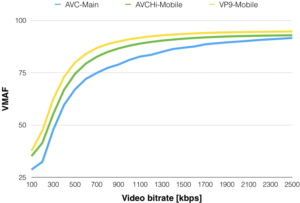Netflix said in its blog that the recent decision to allow downloading of content, as well as streaming, has also been accompanied by the adoption of Google’s VP9 codec rather than the H.264 codec that it has previously used, or the successor to H.264, HEVC (H.265). Currently Netflix uses the H.264/AVC Main profile, but will adopt VP9 (profile 0) and H.264/AVC High profile. Check the link for the technical reasons for the change in profile, but the result is a a saving of between 15% and 19% depending how you measure and around 36% for VP9. Netflix is calling these encodings its’ mobile’ encodes.
VMAF vs Bitrates – source:Netflix
Analyst Comment
VP9 was developed an open source codec by Google and so is supported by Chrome, which is widely supported. It seems unlikely that Apple will change to support VP9 on its iPhones, which could be why Netflix is also supporting the H.264 versions. Netflix has also been doing more work to optimise its compression settings to match content and that is said to have helped to reduce file sizes by 20% or so. The process is performed automatically, with long content being sliced up into pieces of one to three minutes which are analysed and then encoded. Of course, Netflix can use these techniques to boost quality as an alternative to squeezing bitrates or file sizes. (BR)

